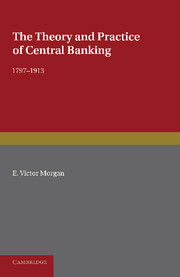Book contents
- Frontmatter
- Contents
- Tables
- Editorial Preface
- Author's Preface
- Chapter I Banks and Banking in the Early Nineteenth Century
- Chapter II The Bank Restriction Period, 1797–1821
- Chapter III Monetary Theory of the Bank Restriction Period
- Chapter IV The First Years of Resumption, the Crisis of 1825, and the Bank Charter Act, 1833
- Chapter V The Horsley Palmer Experiment, and the Bank Charter Act, 1844
- Chapter VI The Currency and Banking Controversy
- Chapter VII The Trial of the Bank Charter Act, 1844-58
- Chapter VIII The Great Boom, 1858-73
- Chapter IX The Great Depression, 1873-96
- Chapter X The Last Years of the Gold Standard, 1897–1913
- Chapter XI Monetary Theory of the Second Half of the Nineteenth Century
- Appendix Changes in Bank rate, 1876-1913, with the Amount of the Reserve of the Banking Department and the “Proportion” on the preceding Wednesday
- Index
Chapter III - Monetary Theory of the Bank Restriction Period
Published online by Cambridge University Press: 05 June 2016
- Frontmatter
- Contents
- Tables
- Editorial Preface
- Author's Preface
- Chapter I Banks and Banking in the Early Nineteenth Century
- Chapter II The Bank Restriction Period, 1797–1821
- Chapter III Monetary Theory of the Bank Restriction Period
- Chapter IV The First Years of Resumption, the Crisis of 1825, and the Bank Charter Act, 1833
- Chapter V The Horsley Palmer Experiment, and the Bank Charter Act, 1844
- Chapter VI The Currency and Banking Controversy
- Chapter VII The Trial of the Bank Charter Act, 1844-58
- Chapter VIII The Great Boom, 1858-73
- Chapter IX The Great Depression, 1873-96
- Chapter X The Last Years of the Gold Standard, 1897–1913
- Chapter XI Monetary Theory of the Second Half of the Nineteenth Century
- Appendix Changes in Bank rate, 1876-1913, with the Amount of the Reserve of the Banking Department and the “Proportion” on the preceding Wednesday
- Index
Summary
MONETARY AND REAL ECONOMICS
The Bank Restriction Period is the earliest time at which we can accurately speak of monetary theory as a separate branch of economics; the beginning of a separation which was to be very much emphasised in the later nineteenth century, with unfortunate consequences.
It is true of the Mercantilists, if a body of writers holding such diverse opinions may be grouped together under a common label, that they attached too much importance to the precious metals. They thought of a gold reserve as a potential war chest, and they were thinking “power economics” in states which were playing a game of “power politics”. It was necessary to develop, as an antidote to this, a system of “real economics”, the economics of human effort and human happiness, just as utilitarian political theory was a necessary antidote to the totalitarian political practice of the eighteenth century. But the change which came with the Physiocrats and Adam Smith was loss as well as gain.
Smith begins his work with a statement of the labour theory of value. He says:
The real price of everything, what everything costs to the man who wants to acquire it, is the toil and trouble of acquiring it. What everything is really worth to the man who has acquired it, and wants to dispose of it, is the toil and trouble which it can save to himself, and impose upon other people. What is bought with money or with goods is purchased by labour, as much as what we acquire by the toil of our own body It was not by gold or by silver, but by labour, that all the wealth of the world was originally purchased; and its value, to those who possess it, and who want to exchange it for some new productions, is precisely equal to the quantity of labour which it can enable them to purchase or command.
Smith follows this with a very modern statement of an “equilibrium theory” of money prices, but he does so only in parenthesis, before returning to the discussion of how the natural price, or labour value, is divided between wages, profits and rent.
Ricardo re-states the labour theory of value in his Principles of Political Economy almost as a truism.
- Type
- Chapter
- Information
- The Theory and Practice of Central Banking, 1797–1913 , pp. 49 - 74Publisher: Cambridge University PressPrint publication year: 2013

